AA
Breakup of China’s Yunhai-1 (02) satellite linked to space debris collisionMało szczegółów nt chińskich megakonstelacji. Na razie jest to dopiero na etapie wyłaniania się.China’s megaconstellation project establishes satellite cluster in Chongqingby Andrew Jones — January 12, 2022
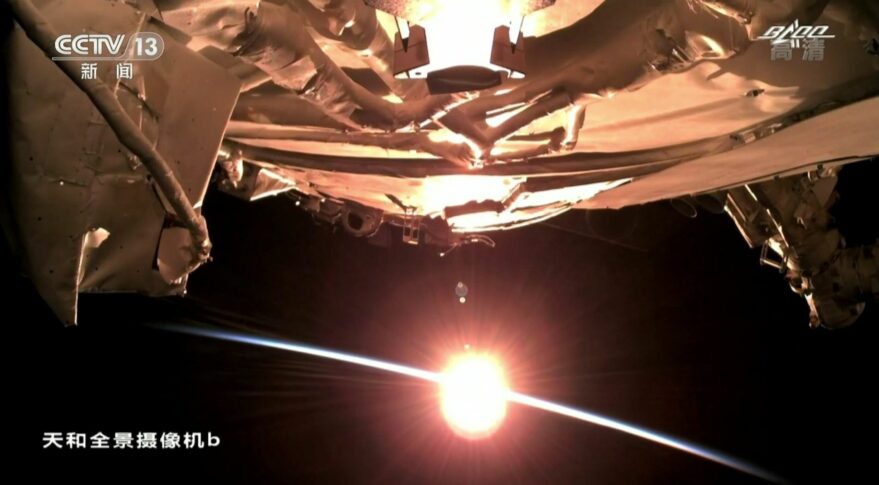 A view from China's Tianhe space station core module ahead of the Shenzhou-12 docking in 2021. Credit: CCTV/BACC/screenshot
A view from China's Tianhe space station core module ahead of the Shenzhou-12 docking in 2021. Credit: CCTV/BACC/screenshot(...) The recently approved 14th Five-year Plan for the period 2021-2026 and “long-range objectives through 2035” call for an integrated network of communications, Earth observation, and navigation satellites. (...)
Hongyan was to consist of more than 300 satellites. CASC stated plans to have an initial 60 satellites in orbit by 2022. Only one prototype was launched, Hongyan-1, in 2018.
Hongyan and Hongyun, another LEO communications megaconstellation planned by CASC’s fellow giant state-owned defense company, the China Aerospace Science and Industry Corporation (CASIC), have apparently been superseded by the national project.
The settling of the new companies in the same area as CASC’s earlier project, which initially drew investment of about $3.14 billion, could however indicate a big role and influence for CASC in the national project. (...)
https://spacenews.com/chinas-megaconstellation-project-establishes-satellite-cluster-in-chongqing/China’s Landspace appears to be preparing to launch its new methane-fueled rocketby Andrew Jones — January 18, 2022 [SN]
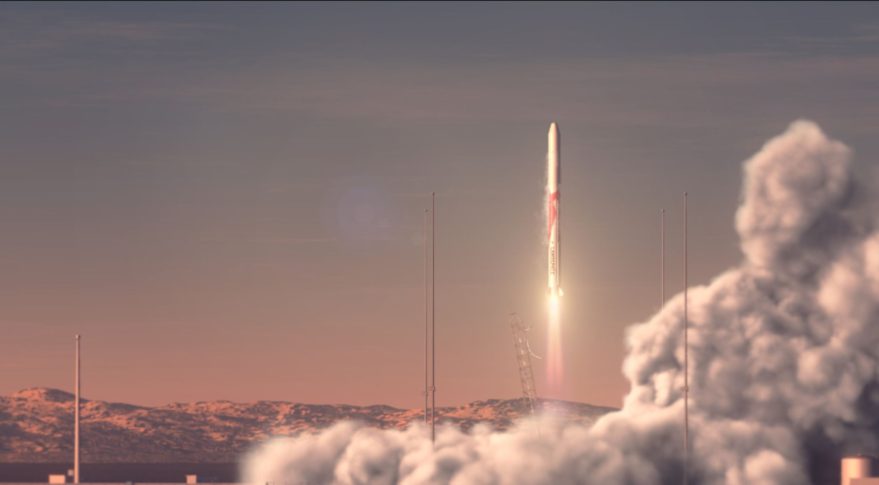 Artist's impression of a Landspace Zhuque rocket launch. Credit: Landspace
Artist's impression of a Landspace Zhuque rocket launch. Credit: LandspaceHELSINKI — Chinese private company Landspace is working towards a first launch of its new methane-fueled Zhuque-2 rocket with the construction of launch facilities at Jiuquan.
Satellite imagery and deleted social media postings indicate that work is progressing on a new complex for facilitating methane-liquid oxygen launch vehicles at Jiuquan Satellite Launch Center in northwest China.
Source:
https://spacenews.com/chinas-landspace-appears-to-be-preparing-to-launch-its-new-methane-fueled-rocket/China’s Galactic Energy raises $200 million for reusable launch vehicle developmentby Andrew Jones — January 24, 2022 [SN]
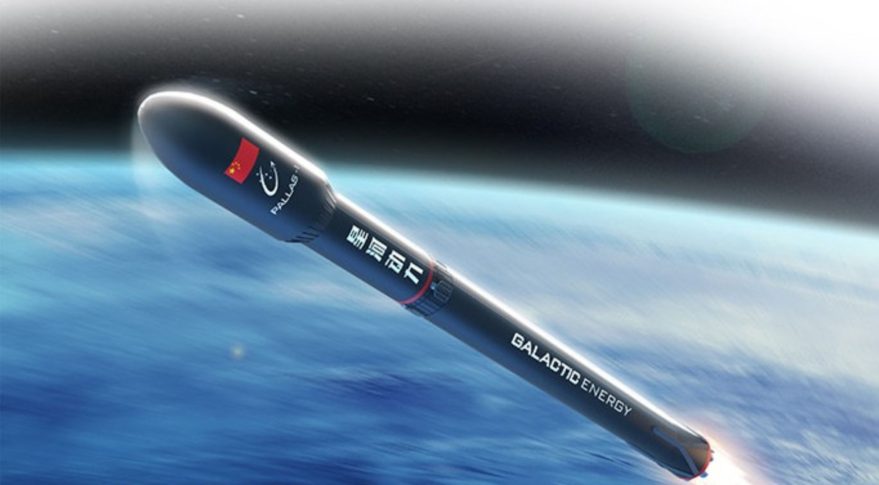 Render of the Galactic Energy Pallas-1 launch vehicle. Credit: Galactic Energy
Render of the Galactic Energy Pallas-1 launch vehicle. Credit: Galactic EnergyHELSINKI — Chinese commercial rocket maker Galactic Energy raised $200 million in two funding rounds during the second half of 2021, the company announced Monday.
Galactic Energy announced that the funding from B and B+ rounds, completed between July and December, would go towards development of the Pallas-1 medium-lift reusable launch vehicle and related infrastructure.
The firm is targeting early 2023 for the first launch of the kerosene-liquid oxygen Pallas-1. The two-stage Pallas-1 is designed to carry 5,000 kilograms to low Earth orbit or 3,000 kilograms to a 700-kilometer Sun-synchronous orbit (SSO). Earlier statements on capabilities stated 4,000 and 2,000 kilograms to LEO and SSO respectively.
https://spacenews.com/chinas-galactic-energy-raises-200-million-for-reusable-launch-vehicle-development/Kosmiczne plany ChinChina presents space plans and priorities in new white paperby Andrew Jones — January 28, 2022 [SN]
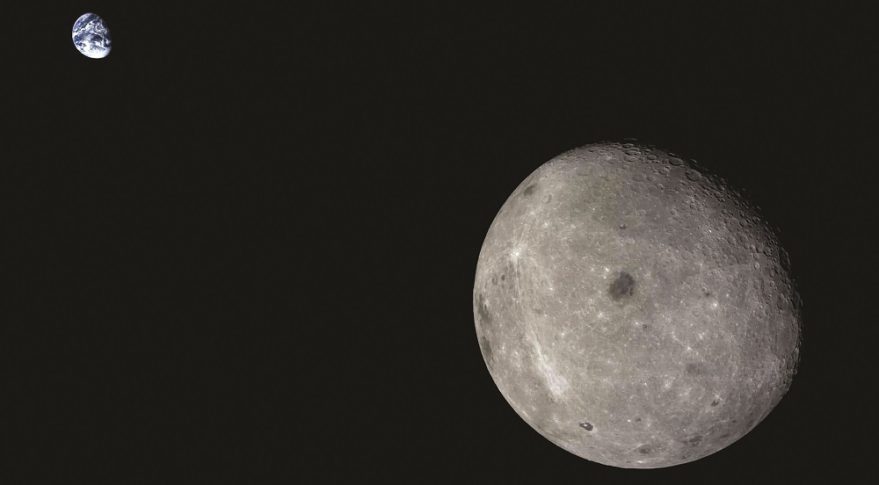 The far side of the moon and distant Earth, imaged by the Chang’e-5 T1 mission service module. Credit: Chinese Academy of Sciences
The far side of the moon and distant Earth, imaged by the Chang’e-5 T1 mission service module. Credit: Chinese Academy of SciencesHELSINKI — China has released a new white paper outlining the centrality of space to the country’s “overall national strategy” as well as major plans for the years ahead.
Over the next five years China will seek to develop its space transportation capabilities, test new technologies, embark on exploration missions, modernize space governance, enhance innovation and boost international cooperation.
Crewed lunar landings, on-orbit servicing and work on planetary defense are all noted as key areas for research and technical breakthroughs in the coming years, the paper reveals, while also providing a measure of transparency into a largely closed off Chinese space industry.
https://spacenews.com/china-presents-space-plans-and-priorities-in-new-white-paper/China’s Deep Blue Aerospace targets big national, commercial launch opportunitiesby Andrew Jones — January 31, 2022 [SN]
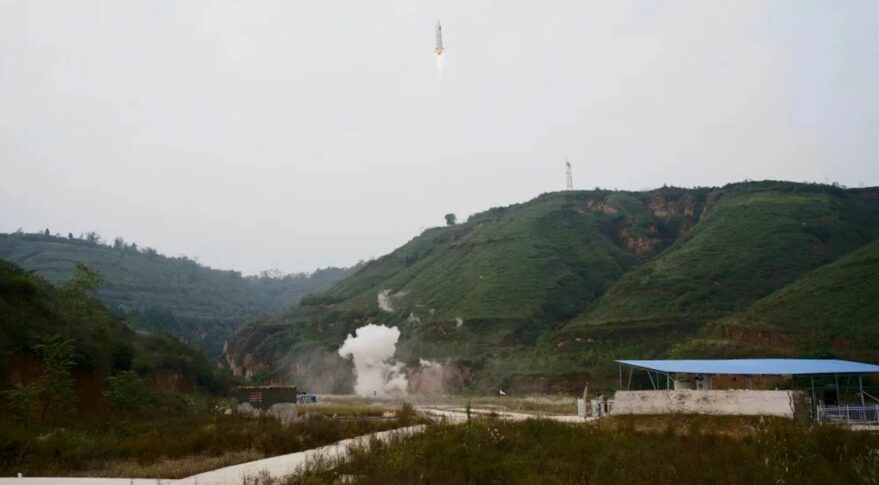 A 100-meter-altitude vertical takeoff, vertical landing test at Tongchuan, Shaanxi Province, conducted by Deep Blue Aerospace, October 13, 2021. Credit: Deep Blue Aerospace
A 100-meter-altitude vertical takeoff, vertical landing test at Tongchuan, Shaanxi Province, conducted by Deep Blue Aerospace, October 13, 2021. Credit: Deep Blue AerospaceHELSINKI — Commercial space activities have developed rapidly in China in recent years, with major government policy shifts allowing a series of launch startups to emerge and compete for new opportunities.
Deep Blue Aerospace, one of a second wave of companies that followed the first few early entrants, is now pushing to reach orbit with its Nebula-1 rocket in 2023 — while also landing the first stage.
In October at an aerospace test base in Tongchuan, Shaanxi province, Its Nebula-M test stage rose to a height of 103.2 meters above its verdant surroundings before beginning to descend, engine still burning. The variable thrust Leiting-5 electric-pump-fed kerosene-liquid oxygen engine brought the vehicle slowly back to Earth and, despite a bounce and a wobble, the Nebula-M remained upright.
https://spacenews.com/chinas-deep-blue-aerospace-targets-big-national-commercial-launch-opportunities/China plans more than 50 space launches in 2022by Andrew Jones — February 9, 2022 [SN]
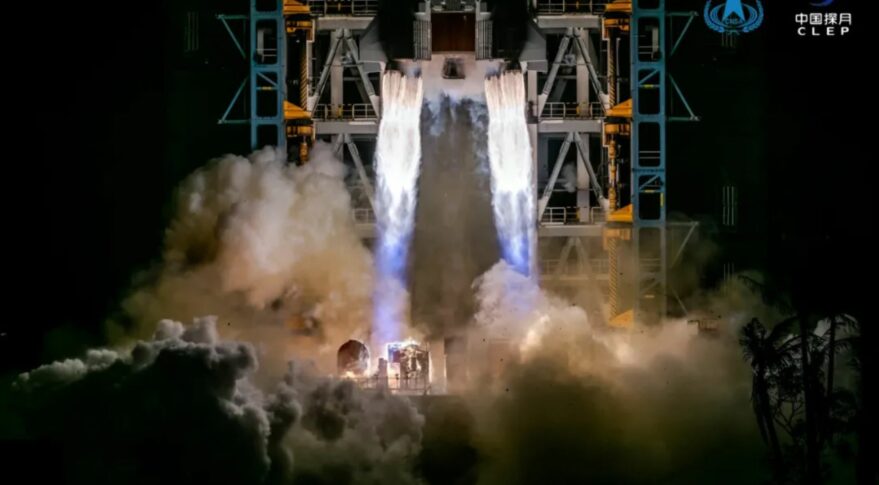 A Long March 5 launches the Chang'e-5 lunar sample return mission Nov. 23, 2020. Credit: CNSA
A Long March 5 launches the Chang'e-5 lunar sample return mission Nov. 23, 2020. Credit: CNSAHELSINKI — China’s main space contractor aims to launch at least 140 spacecraft across more than 50 launches in 2022 following its busiest year in space so far.
The updated target, coupled with the launch plans of other Chinese state-owned enterprises and new private firms, means China could potentially exceed 60 launches in 2022.
The China Aerospace Science and Technology Corporation revealed the plans in an annual ‘blue book’ on space activities, released Feb. 9.
https://spacenews.com/china-plans-more-than-50-space-launches-in-2022/Chinese space launch startups attract a frenzy of investmentby Andrew Jones — February 10, 2022 [SN]
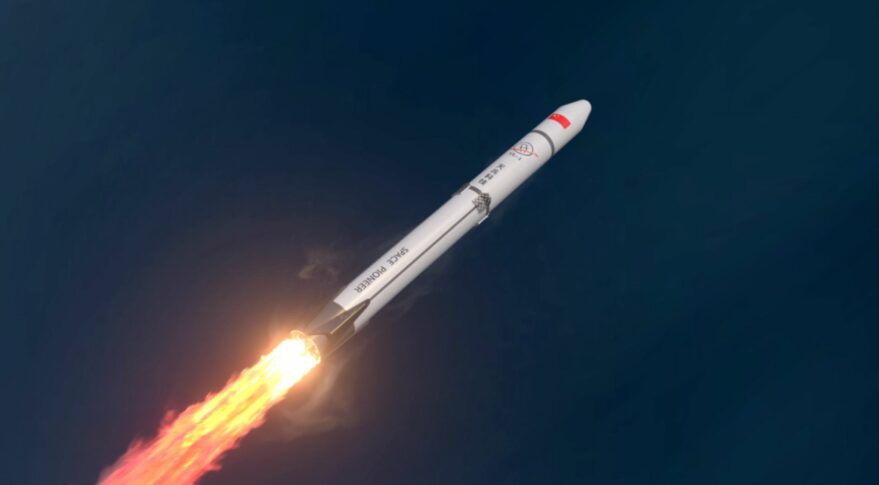 Render of a Tianlong commercial reusable launch vehicle being developed by China's Space Pioneer. Credit: Space Pioneer
Render of a Tianlong commercial reusable launch vehicle being developed by China's Space Pioneer. Credit: Space PioneerHELSINKI — A number of China’s emerging rocket companies have secured major funding rounds in recent weeks as competition to reach orbit intensifies.
Space Pioneer, full name Beijing Tianbing Technology Co., Ltd., announced “major strategic funding” on Feb. 8, led by state-owned investment vehicles and is targeting its first orbital launch this year.
https://spacenews.com/chinese-space-launch-startups-attract-a-frenzy-of-investment/Starship lookalike among China’s new human spaceflight conceptsby Andrew Jones — February 17, 2022 [SN]
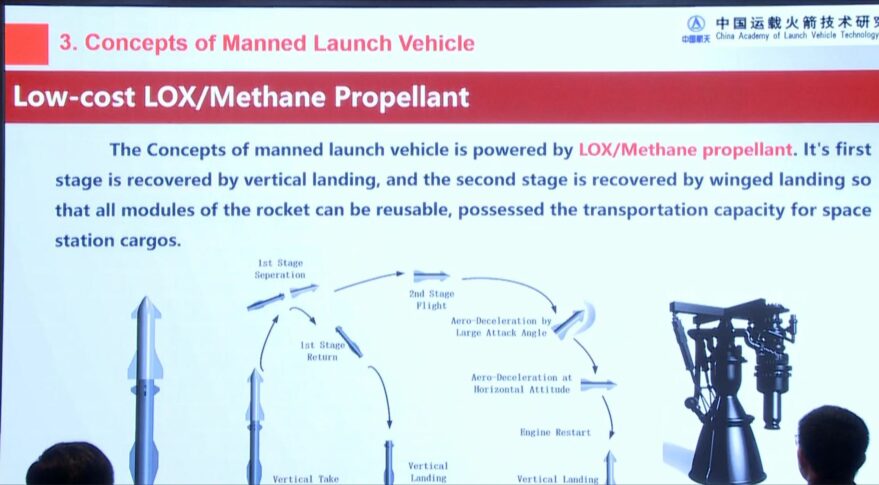 A slide illustrating a concept for a methane-fueled launcher for human spaceflight from the China's CALT. Credit: IAF/CSA/CALT
A slide illustrating a concept for a methane-fueled launcher for human spaceflight from the China's CALT. Credit: IAF/CSA/CALTHELSINKI — China is researching and developing new vehicles for various human spaceflight missions, including a new methane-fueled launcher apparently inspired by SpaceX.
The country is working on a new generation reusable launch vehicle for missions to low Earth orbit (LEO) and beyond, based on developed technologies, a winged space transportation system, and a fully reusable and low cost, two-stage methane-liquid oxygen launcher, apparently drawing on SpaceX’s Starship system concept.
https://spacenews.com/starship-lookalike-among-chinas-new-human-spaceflight-concepts/China is developing new solid rockets to boost overall space capabilitiesby Andrew Jones — March 18, 2022 [SN]
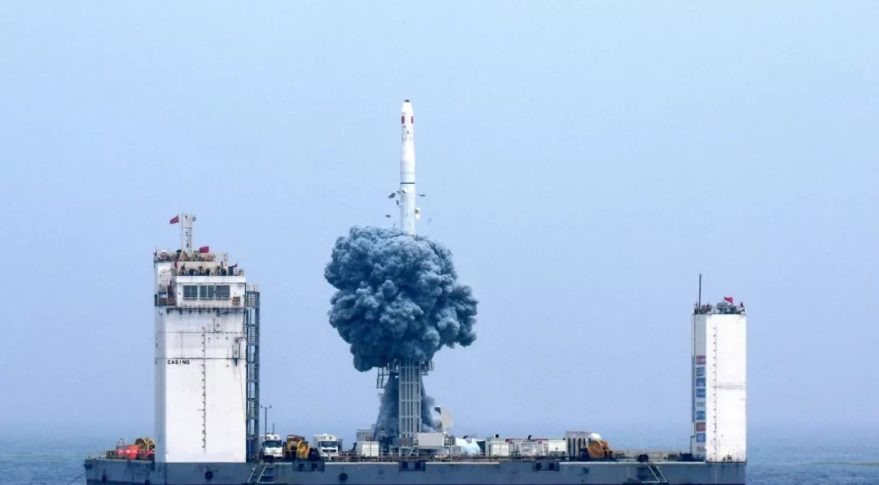 Liftoff of the Long March 11 from a mobile platform in the Yellow Sea, June 5, 2019. Credit: China Academy of Launch Vehicle Technology (CALT).
Liftoff of the Long March 11 from a mobile platform in the Yellow Sea, June 5, 2019. Credit: China Academy of Launch Vehicle Technology (CALT).HELSINKI — Chinese state-owned entities are developing a growing range of solid rockets to meet growing launch demands and contribute to a wider strategy of making China a fully-fledged space power.
Source:
https://spacenews.com/china-is-developing-new-solid-rockets-to-boost-overall-space-capabilities/China’s Shijian-21 towed dead satellite to a high graveyard orbitChina to launch Einstein Probe in 2023 to observe violent cosmic eventsby Andrew Jones — March 30, 2022 [SN]
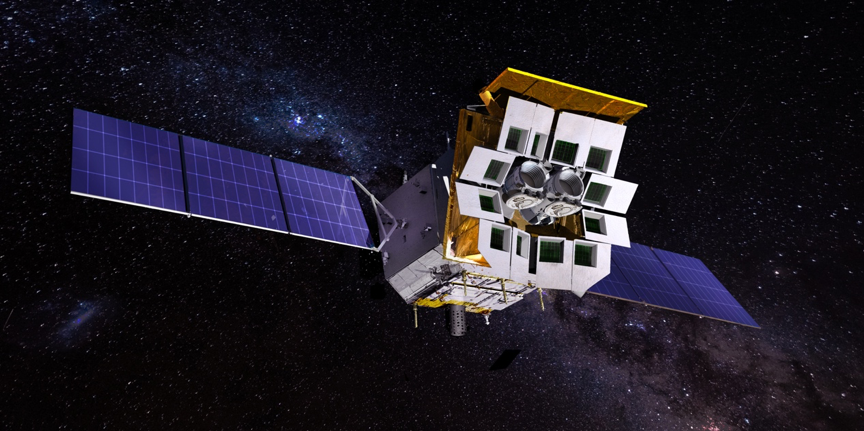
HELSINKI — A Chinese wide-field x-ray space observatory has passed a major review and is expected to launch next year to detect flashes from cataclysmic cosmic events.
The Einstein Probe is expected to launch around mid-to-late 2023 to observe distant, violent interactions such as tidal disruption events—in which stars are pulled apart by supermassive black holes—supernovae, and detect and localize the high-energy, electromagnetic counterparts to gravitational wave events.
A March 25 review session organized by the National Space Science Center (NSSC) under the Chinese Academy of Sciences (CAS) approved the mission to proceed to the spacecraft assembly, integration and testing phase, ahead of an expected launch next year.
https://spacenews.com/china-to-launch-einstein-probe-in-2023-to-observe-destructive-cosmic-events/New Chinese small sat manufacturing capacity could have international ramificationsby Andrew Jones — April 6, 2022 [SN]
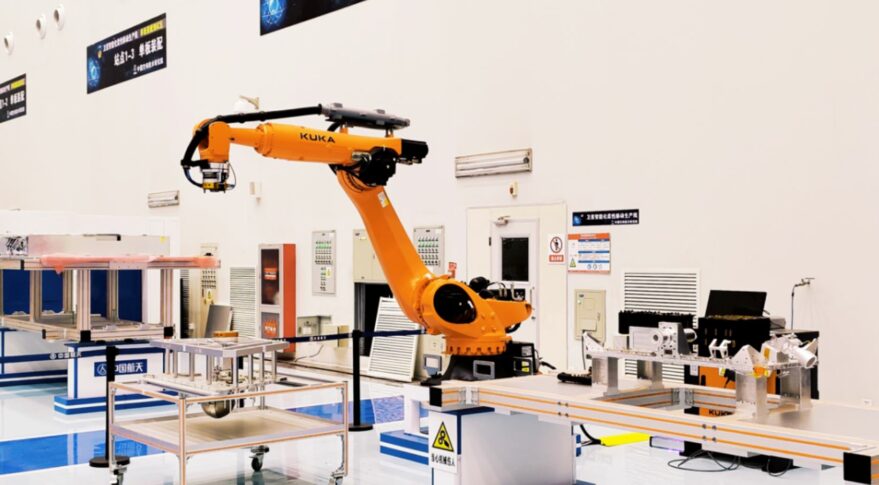 Inside the CAST smallsat manufacturing factory in Tianjin, north China. Credit: CASC
Inside the CAST smallsat manufacturing factory in Tianjin, north China. Credit: CASCHELSINKI — Two new Chinese factories capable of producing hundreds of small satellites per year could help China achieve space objectives and impact the international market.
Production trials are now underway at a new facility belonging to the China Academy of Space Technology (CAST). The plant, situated within CAST’s aerospace industrial base in Tianjin, north China, will be capable of producing more than 200 satellites per year according to the company.
This adds to capacity developed by the China Aerospace Science and Industry Corporation (CASIC), a giant missile maker and defense contractor, which last year completed its own factory in Wuhan and will eventually be capable of manufacturing 240 small satellites each year.
https://spacenews.com/new-chinese-small-sat-manufacturing-capacity-could-have-international-ramifications/China launches three space missions, debuts new rocket configurationApril 11, 2022 Stephen Clark [SFN]
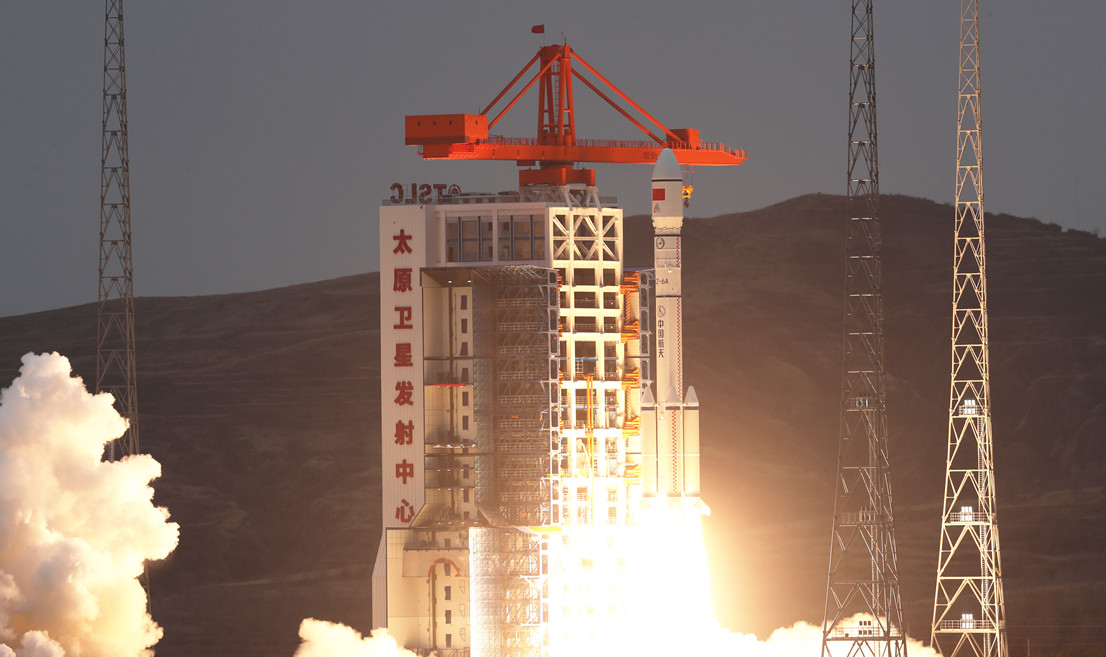 China’s first Long March 6A rocket, with four strap-on solid rocket boosters, lifted off March 29 from the Taiyuan launch base. Credit: CASC
China’s first Long March 6A rocket, with four strap-on solid rocket boosters, lifted off March 29 from the Taiyuan launch base. Credit: CASCChina launched three more space missions in recent weeks, debuting the country’s first rocket to be fitted with strap-on solid-fueled boosters and deploying satellites to image planet Earth and calibrate orbit prediction models, according to Chinese state media.
A new version of China’s Long March rocket family, the Long March 6A, launched for the first time March 29 with two satellites. The Long March 6A is China’s first satellite launcher to feature solid rocket boosters, a thrust configuration commonly used on U.S., European, and Japanese rockets.
https://spaceflightnow.com/2022/04/11/china-launches-three-more-space-missions-debuts-new-rocket-configuration/Space domain awareness: A secret weapon against shadowy threats in orbitby Sandra Erwin — April 14, 2022 [SN]
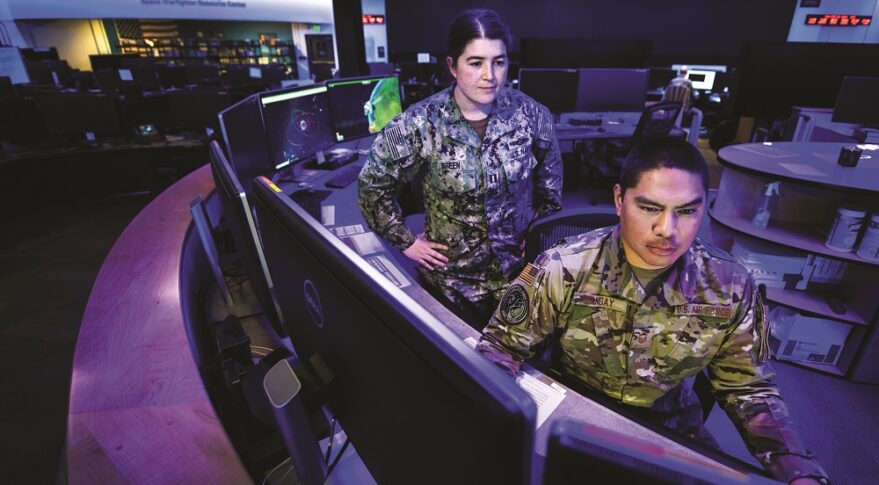 Lt. Nicole Breen, Navy intelligence officer, and Master Sgt. Kenneth Bangay, Air Force cyber systems operator, are at work at the National Space Defense Center at Schriever Air Force Base, Colorado. Credit: U.S. Space Force photo by Kathryn Damon
Lt. Nicole Breen, Navy intelligence officer, and Master Sgt. Kenneth Bangay, Air Force cyber systems operator, are at work at the National Space Defense Center at Schriever Air Force Base, Colorado. Credit: U.S. Space Force photo by Kathryn DamonWhen China fired a missile into one of its own weather satellites in a 2007 show of force, experts called the demo the beginning of a new antisatellite arms race. Fast forward to 2022, and a Chinese space tug is spotted towing a dead navigation satellite into a graveyard orbit above the geostationary belt.
“This is the type of space event that makes the hair on the back of people’s necks stand up,” said Brian Young, a former space control officer at the U.S. Air Force Space Command and now vice president of KBR’s military space business.
https://spacenews.com/space-domain-awareness-a-secret-weapon-against-shadowy-threats-in-orbit/Chinese Shiyan-10 satellite reappears in new Molniya orbit months after launch anomalyby Andrew Jones — April 15, 2022 [SN]
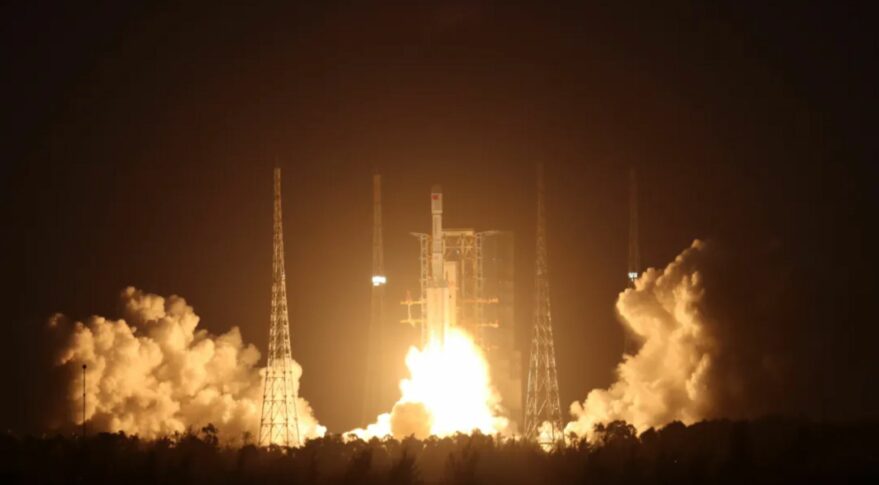 The third Long March 7A rocket lifts off from Wenchang, Dec. 23, 2021, carrying two Shiyan-12 satellites. Credit: CASC/Liu Yan
The third Long March 7A rocket lifts off from Wenchang, Dec. 23, 2021, carrying two Shiyan-12 satellites. Credit: CASC/Liu YanHELSINKI — A classified Chinese satellite has been tracked operating in a specialized orbit, six months after an anomaly during launch appeared to leave it stranded in an initial transfer orbit.
Shiyan-10 is now in a “Molniya” orbit according to tracking data from the U.S. Space Force’s 18th Space Control Squadron (SPCS).
The satellite is in a highly elliptical 1,880 by 38,881 kilometer altitude orbit with an inclination of 63.6 degrees. This indicates that the spacecraft has made a big alteration to its earlier orbital inclination to serve a specific set of tasks over the northern hemisphere.
https://spacenews.com/chinese-shiyan-10-satellite-reappears-in-new-molniya-orbit-months-after-launch-anomaly/Two Chinese rockets deploy telecom and environmental monitoring satellitesApril 18, 2022 Stephen Clark [SFN]
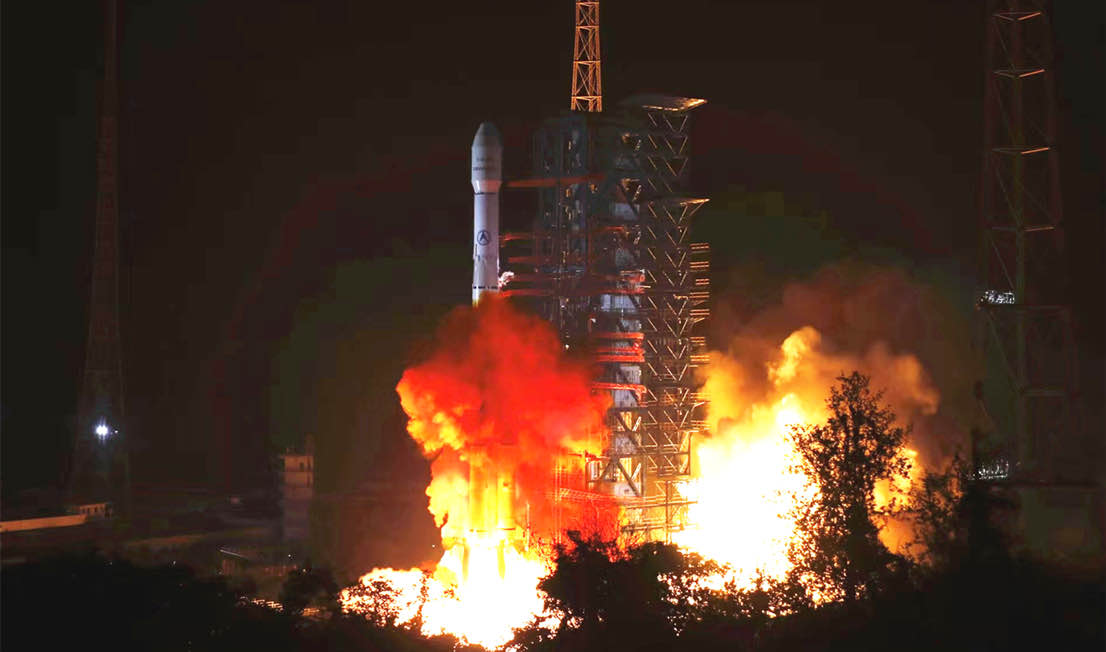 A Long March 3B rocket lifts off with the Chinasat 6D communications satellite. Credit: CASC
A Long March 3B rocket lifts off with the Chinasat 6D communications satellite. Credit: CASCTwo Chinese rocket launches hours apart Friday successfully deployed a radio and TV broadcasting spacecraft and an atmospheric environmental monitoring satellite.
The missions from different spaceports lifted off a little more than six hours apart, continuing China’s 2022 launch campaign, a schedule highlighted by planned flights to expand the country’s space station.
A Long March 3B rocket lifted off from the Xichang launch base in Sichuan province at 1200 GMT (8 a.m. EDT; 8 p.m. Beijing time) Friday with the Chinasat 6D, or Zhongxing 6D, communications satellite. The 18-story-tall launcher steered southeast from Xichang, nestled in a hilly region of southwestern China, and shed its four liquid-fueled boosters and core stage about two-and-a-half minutes into the mission.
A second stage and hydrogen-fueled third stage delivered the Chinasat 6D satellite into an elongated geostationary transfer orbit stretching more than 22,000 miles (nearly 36,000 kilometers) above Earth at its highest point, with an inclination of 28.5 degrees to the equator, according to publicly-available U.S. military tracking data. (...)
Chinasat 6D, designed for a mission of more than 15 years, will replace the Chinasat 6A satellite launched in 2010.
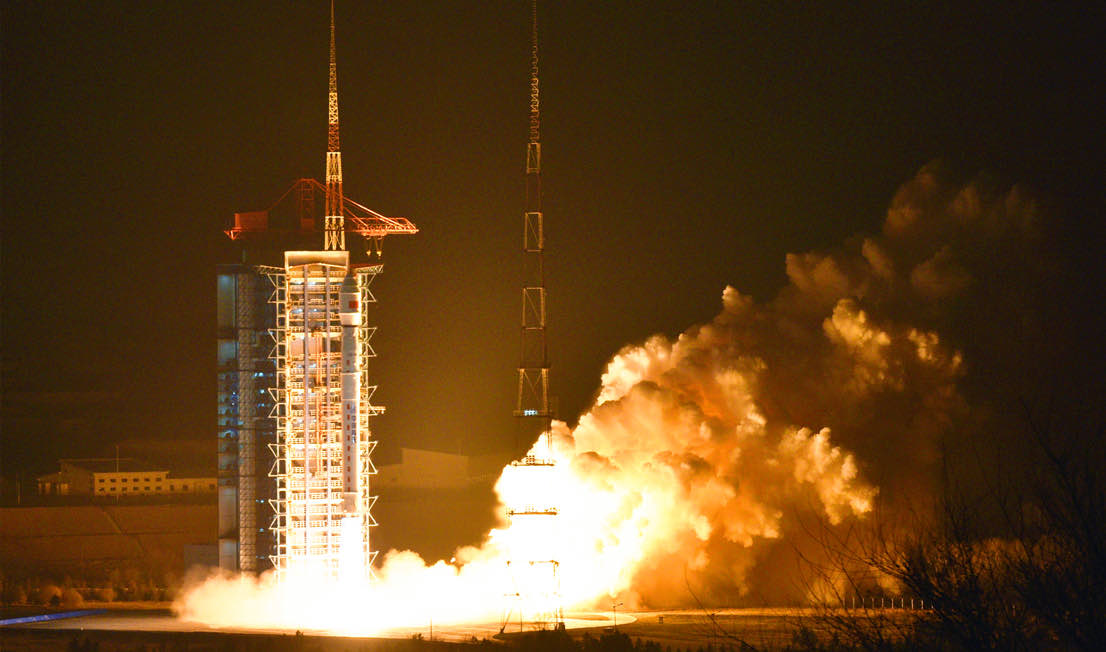 A Long March 4C rocket lifts off with the DQ-1 atmospheric environmental monitoring satellite. Credit: CASC
A Long March 4C rocket lifts off with the DQ-1 atmospheric environmental monitoring satellite. Credit: CASC(...) The satellite, known as DQ-1, will track fine particles, pollutants, greenhouse gases, clouds, and aerosols in the atmosphere, plus land surfaces and water bodies, according to the China National Space Administration — the Chinese space agency — which manages the mission.
The spacecraft’s instruments include an atmospheric detection laser sensor to detect atmospheric carbon dioxide and aerosols, a polarization scanner to measure particulates in the atmosphere, a multi-angle imaging instrument, an ultraviolet hyperspectral atmospheric composition detector, and a wide-field imaging spectrometer, according to CNSA.
Data collected by the DQ-1 satellite will help scientists monitor air pollution and climate change, the Chinese space agency said. (...)
https://spaceflightnow.com/2022/04/18/two-chinese-rockets-deploy-telecom-and-environmental-monitoring-satellites/Chinese reusable rocket startup secures new funding roundby Andrew Jones — April 22, 2022 [SN]
 A 100-meter-altitude vertical takeoff, vertical landing test at Tongchuan, Shaanxi Province, conducted by Deep Blue Aerospace, October 13, 2021. Credit: Deep Blue Aerospace
A 100-meter-altitude vertical takeoff, vertical landing test at Tongchuan, Shaanxi Province, conducted by Deep Blue Aerospace, October 13, 2021. Credit: Deep Blue AerospaceHELSINKI — Chinese launch firm Deep Blue Aerospace announced A+ round financing April 19, with funding in the Chinese commercial sector apparently on the rise.
The new round was led by CMBC Int’l Holdings, three months after Deep Blue Aerospace raised $31.5 million in A round funding.
https://spacenews.com/chinese-reusable-rocket-startup-secures-new-funding-round/China’s Wenchang aims to become commercial space hubby Andrew Jones — April 28, 2022 [SN]
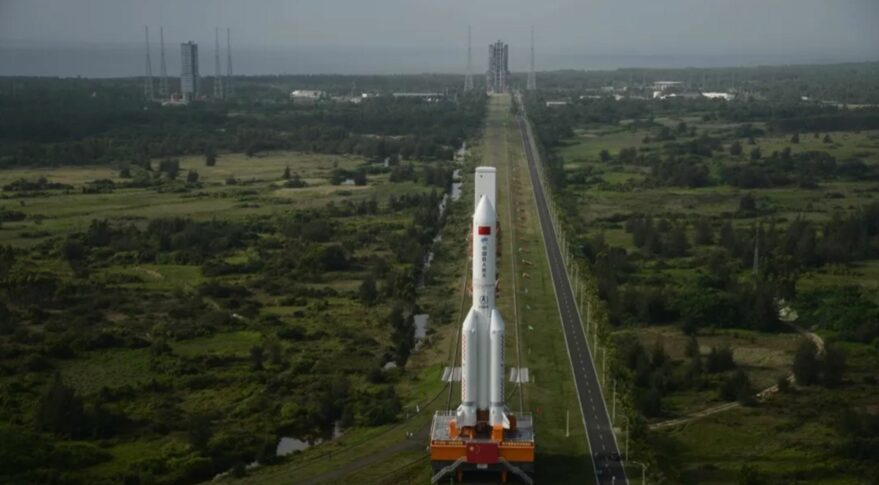 Rollout of the first Long March 5B to the pad at Wenchang, South China in April 2020. Credit: CASC
Rollout of the first Long March 5B to the pad at Wenchang, South China in April 2020. Credit: CASCHELSINKI — A southern city hosting China’s newest, transformative spaceport is pushing to become a hub for commercial and international space activity.
Wenchang International Aerospace City will accelerate efforts to establish a commercial launch site and rocket assembly plants, according to ThePaper.
https://spacenews.com/chinas-wenchang-aims-to-become-commercial-space-hub/